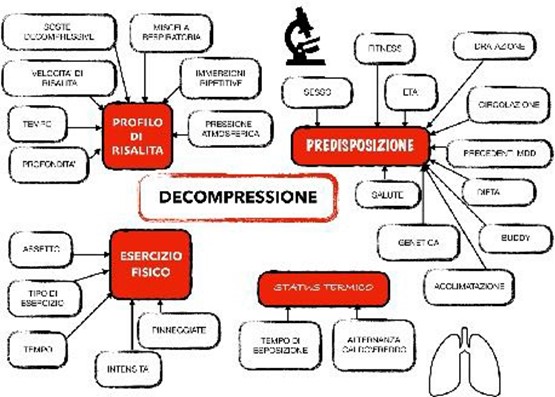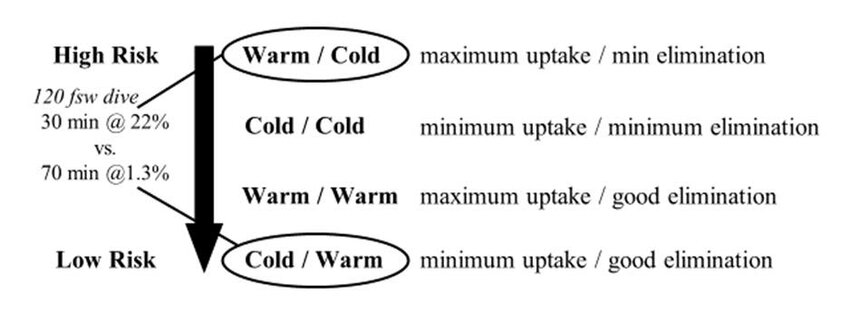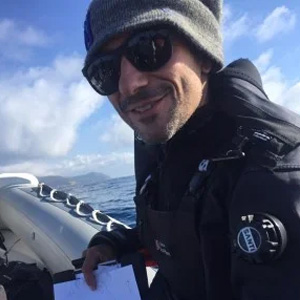Diving decompression is a fundamental procedure to ensure the safety of every dive.
When a diver ascends to the surface after spending time at depth, the dissolved breathing gases in the tissues are gradually eliminated.
Improper ascent can lead to serious health risks, such as decompression sickness (DCS).
In this article, we’ll explore every aspect of decompression: what it means, how to plan it, and which tools to use to protect your body while diving.
Are you ready to discover everything you need to know to fully enjoy the underwater world? Keep reading!
Index:
- What is diving decompression?
- How is diving decompression done?
- How long does diving decompression take?
- What happens if you skip diving decompression?
- Recognizing decompression sickness
- How to prevent decompression sickness?
- How does cold influence decompression sickness?
What is diving decompression?
Diving decompression is the process that allows the body to safely eliminate inert gases (mainly nitrogen) absorbed during the dive.
When breathing compressed gas at depth, increased pressure causes greater solubilization of gases in the tissues.
Mistakes during ascent, such as ascending too quickly, can cause gas bubbles to form in tissues and blood, leading to symptoms ranging from joint pain to severe complications like gas embolism.
How is diving decompression done?
Decompression involves following specific ascent steps and stops, known as “decompression stops,” determined by decompression algorithms or dive tables.
Here are the main steps:
- Pre-dive Planning: Determine the time and depth of the dive.
- Monitoring During the Dive: Track dive computer data.
- Safety Stops: Stop at predetermined depths during ascent for the time needed to gradually eliminate dissolved gases.
- Breathing Gas Management: Using enriched gases such as Nitrox, oxygen, or Trimix can reduce decompression times.
How long does diving decompression take?
Decompression duration depends on:
- Depth and Bottom Time: Deeper and longer dives require extended ascent times.
- Breathing Gas Mix: Using specific gases like Nitrox, oxygen, or Trimix can reduce decompression times.
- Diver Physiology: Personal factors like age, physical condition, hydration, and thermal state can affect timing.
There’s no strict limit for decompression. It can range from 3–5 minutes for recreational dives to several hours for technical dives and even several days for professional saturation dives.
What happens if you skip diving decompression?
Failing to perform decompression or doing it incorrectly can result in decompression sickness (DCS). This condition occurs when gas bubbles form in tissues or blood, causing:
- Joint and muscle pain.
- Itching, rashes, edema.
- Dizziness and mental confusion.
- Respiratory and cardiovascular issues.
- Severe cases may lead to gas embolism and paralysis.
Immediate treatment includes oxygen therapy, hydration, and, in some cases, recompression in a hyperbaric chamber.
Recognizing decompression sickness
DCS symptoms vary in severity. Common signs include:
- Mild Symptoms: Fatigue, itching, joint pain, rashes.
- Severe Symptoms: Breathing difficulties, dizziness, loss of balance, muscle weakness, unconsciousness.
If DCS is suspected:
- Administer 100% pure oxygen.
- Contact emergency diving services (DAN or other hyperbaric centers).
- Stay hydrated by drinking water.
How to prevent decompression sickness?
A good piece of news: according to many doctors, diving is beneficial. Studies show that regular diving activity progressively builds resistance to oxidative stress, thus reducing the likelihood of developing many illnesses typical of daily life in the Western world. Now, let’s look at what can be done to enhance these beneficial effects of diving. This has been understood for a few years, but recently, specialists are increasingly emphasizing that diving-related decompression incidents have a multifactorial origin. They depend not only on dive parameters but significantly on the diver’s physical condition and their body’s response to the inflammatory state caused by the dive itself.
It is therefore essential to consider a set of best practices to improve decompression efficiency, as gradually outlined.
The causes leading to decompression incidents can be divided into two major groups: those that cannot be modified and those that can.
The non-modifiable causes are essentially two: the diver’s age and their genetic situation.
It is obvious that advanced age may bring certain “weaknesses,” ranging from reduced physical strength (e.g., less ability to handle exertion, carry equipment, swim against currents) to more or less severe or declared chronic illnesses (diabetes, heart diseases) that may prove dangerous.
Moreover, age increases the “inflammatory response,” which, according to the latest studies, is responsible for much of the symptoms of decompression sickness (DCS). The age after which greater attention is needed (though not stopping activity entirely) is 50 years. However, it is clear that personal circumstances can significantly shift this limit and should be evaluated by an expert physician.
Additionally, recent discoveries pertain to genetics. The body’s ability to synthesize certain compounds (e.g., nitric oxide – NO, which has a protective effect on DCS, or other molecules linked to cancer and heart attack risks) varies from individual to individual. This explains, within significant limits, the greater or lesser susceptibility of some people to DCS. In some cases, doctors specializing in this field, if provided with all the necessary clinical data, claim to be able to statistically calculate the personal risk each diver faces.
The modifiable causes, on the other hand, concern both environmental factors (such as knowledge of the dive environment, technical preparation, equipment availability, personal choices) and the diver’s momentary physical condition, essentially their health, which can be improved with proper care.
As with other physical activities, consider factors like hypertension (high blood pressure), high cholesterol, the so-called “biometric indices” (BMI, body mass index, and abdominal circumference), smoking, and the presence of specific personal physical characteristics like a patent foramen ovale (PFO), which can potentially be corrected surgically. All these factors can be adjusted with the help of a doctor and some determination to maintain them within safe values.
Additionally, other elements contribute to best practices for a healthy life, reducing the body’s potential chronic inflammatory state: consistent physical activity (at least 90 minutes per week), a diet rich in fruits, vegetables, and quality products, along with adequate hydration. Beneficial supplements include fresh dehydrated bee pollen, vitamin C (1 gram twice daily for six days and right before the dive), and at least 70% dark chocolate (30 grams before diving).
Some rules directly relate to diving. One guideline concerns the partial pressures of oxygen and nitrogen, which, to limit inflammatory response and other negative phenomena, should not exceed 1.4 and 3.2 bar, respectively. Meanwhile, the presence of helium in the breathing mixture appears to have a protective effect.
In practice, this reinforces the advice to avoid exceeding these depths (“No to deep air diving”), as already suggested by certain diving protocols: beyond 30-40 meters, using Trimix mixtures (oxygen, helium, nitrogen) is highly recommended.
Other recommendations include a two-hour interval between repetitive dives (e.g., the two typical dives of a full-day trip) while highlighting the benefits of frequent diving activity (more than 30 hours per year or frequent dives within a specific period).
Physical activity also plays an important role: intense exertion (running, cycling) should be avoided both in the 24 hours preceding the dive and within two hours after the dive or the following day. Strenuous activity should also be avoided in the water, particularly during descent and at the bottom phase of challenging dives. However, light finning may be helpful during ascent and decompression. In any case, joint overloading should be avoided, possibly using an underwater scooter for assistance.

How does cold influence decompression sickness?
A crucial note must be dedicated to thermal protection. Best practice objectives include avoiding diving when overheated (waiting to reach a balanced state), performing the descent and bottom phase in a “cool” state, and conducting ascent and decompression in a warm state. To achieve this, it is highly beneficial to use a dry suit and an electric heating vest, which can be turned on during the ascent.
This conclusion stems from a well-known study published in November 2007 by the NEDU (Navy Experimental Diving Unit): “The Influence of Thermal Exposure on Diver Susceptibility to Decompression Sickness.”
The experiment was conducted in the hyperbaric facility of the U.S. Navy’s Underwater Research Center in Panama City.
The objective of the research was to determine if and how the thermal status of divers during a dive affects their susceptibility to and quality of decompression sickness (DCS).
To achieve this, a series of dives were carried out within the center’s hyperbaric structure, which allowed researchers to control the divers’ thermal exposure by creating combinations of HOT/COLD conditions during both the deep phase of the dive and the decompression phase.
The divers performed exercises on a cycle ergometer during the deep phase of the dive, wearing swimsuits, t-shirts, booties, and gloves. They remained at rest during decompression and then rested for 4 hours under controlled conditions, during which they were monitored using echocardiograms.
Although no physiological measurements were taken to determine the divers’ exact thermal status, self-assessment scores clearly indicated that the divers felt cold at a temperature of 26.7°C. To feel warm, they needed a temperature of 36.1°C.
While the study’s aim was not to demonstrate the physiological mechanisms underlying the effects of thermal exposure on DCS risk, the results reinforced the idea that gas exchange dynamics in tissues involved in DCS are slowed by vasoconstriction during cold exposure and accelerated by vasodilation during heat exposure.
During the 400 dives conducted to a maximum depth of 37 meters, divided into seven series to test various combinations of thermal conditions, 21 cases of DCS were diagnosed. Below is a summary table of the test results.
It is interesting to note:
- At the same depth, the high incidence of DCS (22.2%) in dives where cold was perceived during both the bottom phase and decompression (C/C) compared to the low incidence in dives where cold was only perceived during the bottom phase (C/W) clearly indicates that heat exposure during decompression helps prevent DCS. The incidence of DCS remained low (1.3%) even in tests conducted at the same depth but with a 10-minute longer bottom time.
- The beneficial effects of heat during decompression were more pronounced than the detrimental effects of heat during the bottom phase. Furthermore, a 10°C temperature increase during decompression had effects comparable to halving the bottom time.
- Since the incidence of DCS was similar for dives at 37m/30min W/C and 37m/60min C/C, it is evident that heat exposure during the bottom phase is unfavorable.
- Temperature changes of 10°C appear to have effects comparable to doubling or halving the bottom time.
- Heat during the bottom phase can accelerate gas absorption and increase DCS risk, whereas the same conditions during decompression accelerate gas elimination and reduce DCS risk.

Given these results, it is clear that these effects should be incorporated as independent variables in decompression models. Such model improvements, along with further in-depth research, are necessary to quantify the relationships underlying perceived temperature effects and to establish optimal thermal conditions in which the benefits of decompression under warm conditions can be fully realized.
—
Diving decompression is an essential component of safe and enjoyable diving.
Following proper procedures, using appropriate equipment, and carefully planning your dive are crucial steps to minimize risks and fully enjoy the wonders of the underwater world.
If you want to delve deeper into decompression techniques or need support to improve your diving skills, Argentario Divers is here for you!
With years of experience and a team of qualified instructors, we can help you explore the sea safely.
Contact us for information on our courses, guided excursions, and personalized consultations. Your next diving adventure awaits!
Call now or visit our website to discover all the opportunities available.



